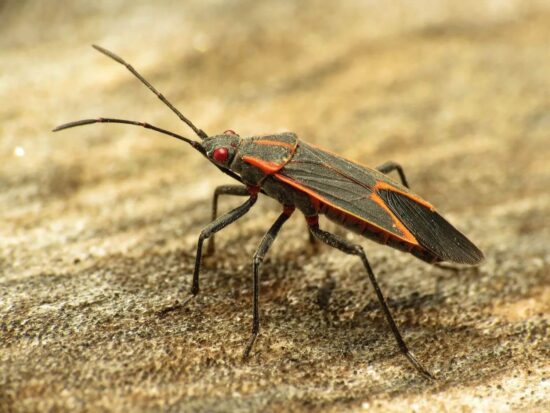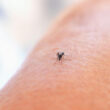Those pesky black bugs with red markings crawling all over your house? Those are boxelder bugs, and they’re probably looking for a warm place to spend the winter. These half-inch long critters aren’t dangerous, but they sure are annoying when they show up by the hundreds.
Boxelder bugs love to sneak into homes during fall when the weather gets cold. Then they hibernate in your walls all winter long, only to wake up and start crawling around your house again in spring. Plus, they leave behind smelly stains when you squish them, and their poop can stain your curtains and furniture.
The good news? Learning how to get rid of boxelder bugs isn’t as hard as you might think. The key is using several different methods together, not just relying on one trick. Let’s jump into the most effective ways to send these bugs packing.
1. Vacuum Them Up Right Away
The fastest way to get rid of boxelder bugs you can see is to suck them up with your vacuum cleaner. When people ask how to get rid of boxelder bugs quickly, this is always the first method experts recommend. This works great for bugs hanging out on windowsills, in corners, or near doorways.
Here’s how to do it right: Use a vacuum with a bag if you have one, then throw the bag away immediately. These determined little bugs can actually crawl back out if you don’t dispose of the bag right away. For bagless vacuums, empty the canister outside as soon as you’re done.
Pro tip: Try the nylon stocking trick. Put a nylon stocking inside the vacuum tube and secure it with a rubber band over the outside of the tube. This catches the bugs before they get into your vacuum bag.
After vacuuming, clean the area with warm soapy water. This removes any scent trails the bugs left behind that might attract more of their friends.
2. Seal Up Every Crack and Gap
Prevention beats treatment every time. The best way to manage boxelder bugs is to keep them from entering your home from the start. Think of your house like a fortress and seal up every possible entry point.
Focus on these problem areas:
- Windows and door frames
- Foundation cracks
- Where utility lines enter your house
- Roof lines and the edges of your roof
- Dryer vents and bathroom fans
Use silicone caulk for small gaps and expandable foam for bigger spaces. Install door sweeps on all exterior doors and add weatherstripping around windows. Don’t forget to check and fix any torn window screens.
The best time to do this sealing work? Complete all repairs before the end of August, when boxelder bugs start looking for winter hideouts.
3. Hit Them with Soapy Water
This simple spray works like magic against boxelder bugs. Getting rid of boxelder bugs with soapy water is one of the most effective DIY methods available. Mix one to two tablespoons of liquid dish soap with water in a spray bottle. When you spray it directly on the bugs, the soap breaks down their protective outer coating, which makes them dry out and die.
This method kills bugs on contact, but it won’t stop new ones from showing up. Still, it’s super effective for dealing with clusters of bugs you can see. Make sure to saturate the bugs fully with the soapy water mixture.
After spraying, carefully scoop up the dead bugs and throw them away. Don’t crush them with your hands because they’ll release a nasty smell that actually attracts more bugs to the area.
4. Try Natural Repellent Sprays
- Plant-based peppermint oil formula repels pests naturally
- Safe to use around pets, kids, and indoor living spaces
- Great for garages, attics, baseboards, and outdoor areas
- Fresh mint scent with long-lasting protection
Nature has some great bug-fighting tools that are safe for your family and pets. If you’re wondering how to get rid of boxelder bugs without harsh chemicals, these natural sprays work by making your home smell terrible to boxelder bugs, even though they might smell pretty good to you.
Essential Oil Sprays
Peppermint oil contains menthol, which acts as a sensory irritant for boxelder bugs. It basically makes your home feel uncomfortable and confusing to them, so they look for somewhere else to hang out.
Mix 10 drops of essential oil with one cup of water in a spray bottle. The most effective oils are:
- Peppermint (the top choice)
- Eucalyptus
- Clove
- Lavender
- Tea tree oil
Spray these mixtures around windows, doors, and anywhere you think bugs might try to sneak in. You’ll need to reapply every few days to keep it working.
Neem Oil Treatment
Neem oil works as a natural insecticide that messes with the bugs’ life cycle by interfering with their growth and ability to reproduce. Mix two tablespoons of neem oil with two cups of water, then spray it on trees and plants where you see bugs gathering.
The cool thing about neem oil is that it’s completely non-toxic and safe to use on plants. You can even use it on crop plants just 24 hours before harvest.
White Vinegar Spray
Plain white vinegar works as a bug repellent because they hate the smell. Vinegar also cancels out the hormone signals that boxelder bugs use to communicate with each other.
Fill a spray bottle with pure white vinegar (don’t use other types because they can stain). Spray it around areas where bugs like to gather. This method repels bugs rather than killing them, but it’s completely safe for kids and pets.
5. Spread Diatomaceous Earth Around
- Kills fleas, ants, roaches, and more
- Includes powder duster for easy, targeted application
- Works indoors and outdoors, long-lasting when dry
- 100% pure, food-grade, safe around pets and kids
Diatomaceous earth is a natural, organic powder that kills boxelder bugs by absorbing their waxy outer layer, causing them to dry out and die. Even better, it’s totally safe for humans and pets.
Sprinkle a thin layer of food-grade diatomaceous earth around entry points, windowsills, and anywhere you’ve seen bugs. Remember that a little goes a long way, and using too much can hurt beneficial insects.
You’ll need to reapply this powder after it rains, and it works slowly compared to sprays. But it’s a great long-term solution that keeps working even when you’re not around.
6. Use Borax Powder Barriers
Borax contains sodium borate salts that work like a natural pesticide. When bugs eat it or even just walk through it, it damages their digestive system and nervous system.
Sprinkle borax powder around the base of trees, entry points, and along your foundation. The powder slowly cuts through the bugs’ outer shells, leaving them to dry out and die.
Important safety note: Keep borax away from children and pets, and wear gloves when you’re handling it. Borax can be a skin and eye irritant, so treat it with respect even though it’s natural.
7. Plant Bug-Repelling Plants
Why not make your yard beautiful and bug-free at the same time? Some gardeners say that boxelder bugs hate the scent of mums, citrus plants, and herbs like sage, cloves, and lavender.
Plant these around your foundation and near windows and doors. Peppermint is especially good because it’s easy to grow and doesn’t need much care. You can also use these plants to make fresh essential oil sprays.
If you don’t want to plant anything, make small herb sachets with sage, whole cloves, and lavender and place them in areas where bugs tend to gather inside your house.
8. Clean Up Your Yard and Manage Trees
Boxelder bugs need food and shelter, so taking away both makes your property less appealing to them.
Deal with Host Trees
Boxelder bugs get their name because they love to feed on boxelder tree seeds, but they also eat from maple and ash trees. If you have these trees on your property, you can:
- Rake up and throw away fallen seeds in spring (young bugs survive on these seeds)
- Trim trees regularly to reduce the amount of food available
- Remove dead branches and clean up fallen leaves
Removing the trees completely might only reduce bug numbers slightly because adult bugs can fly in from trees that are hundreds of yards away.
Remove Hiding Spots
Boxelder bugs look for shelter in wood piles, leaf piles, rocks, and overgrown plants. Clean up these areas to make your yard less bug-friendly:
- Stack firewood away from your house
- Rake up leaf piles regularly
- Trim back overgrown bushes and shrubs
- Create a 6 to 10 foot clear strip around your home by mowing weeds and grass short
Regular yard maintenance goes a long way toward preventing bug problems.
9. Set Up Sticky Traps
Glue traps and sticky pads come in different shapes and sizes and work by trapping bugs when they walk across them. Place them around your home’s perimeter and near entry points.
These traps work especially well in basements, garages, and sheds where bugs like to hide. Just make sure to check them often and throw them away when they’re full to avoid nasty smells.
One thing to remember: boxelder bugs attract other boxelder bugs, so you don’t want to leave full traps sitting around too long.
10. Call in the Professionals
Sometimes DIY methods aren’t enough, especially if you’re dealing with a serious infestation or if bugs keep coming back year after year. Professional pest control experts know exactly how to get rid of boxelder bugs for good.
When to Call for Help
Professional pest control makes sense when:
- You’ve tried multiple DIY methods without success
- Bugs keep coming back despite your efforts
- You’re seeing hundreds of bugs at once
- You want to prevent problems before they start
Professional Treatment Options
The best time for professional chemical treatment is late summer and early fall when boxelder bugs first start clustering around buildings. Pest control experts can:
- Apply stronger insecticides that aren’t available to the public
- Treat your home twice a year: once in spring/early summer to control young bugs, and once in fall to prevent them from moving in for winter
- Focus on south and west-facing walls where bugs like to gather
- Use professional equipment to reach high places and hard-to-reach spots
Professional treatment works best as part of an integrated program that combines both chemical and non-chemical methods.
When to Take Action
Timing is everything when it comes to boxelder bug control. Here are the most important times to act:
Late Summer/Early Fall (Best Time): Late September to October is the best time to focus on boxelder bug prevention. This is when bugs start looking for winter hideouts, so treating them now prevents months of indoor problems.
Before August Ends: Complete all sealing and exclusion work before the end of August, when bugs become more active in their search for shelter.
Spring: Focus on helping trapped bugs get back outside rather than killing them. Spraying bugs in spring when they’re trying to leave buildings is unnecessary.
What Not to Do
- Don’t crush bugs inside your house (they’ll stain surfaces and smell bad)
- Don’t wait until bugs are already inside to start treatment
- Don’t rely on just one method when dealing with a big infestation
Wrapping Up
Getting rid of boxelder bugs takes patience and the right combination of methods. Start with prevention by sealing up your house, then use natural repellents and physical removal to deal with any bugs that do get in.
Remember that fall prevention treatments are the most important step you can take. A little work in September and October can save you months of dealing with these pests.
Most of the methods in this guide are safe for your family and pets, so you can feel good about protecting your home without using harsh chemicals. And if DIY methods aren’t cutting it, don’t hesitate to call in professional help. Sometimes the best solution is letting the experts handle it while you focus on keeping your home sealed up tight. With the right approach, learning how to get rid of boxelder bugs becomes much more manageable.




